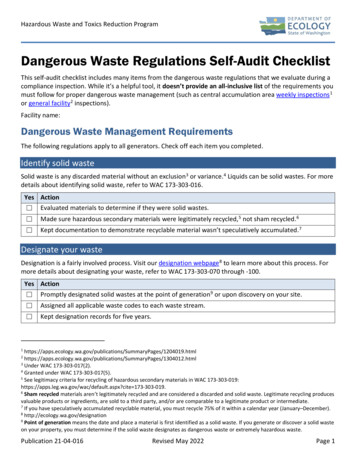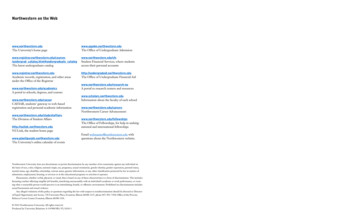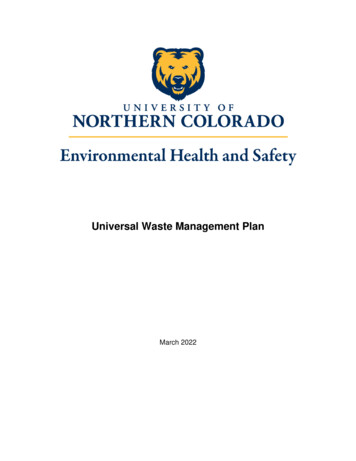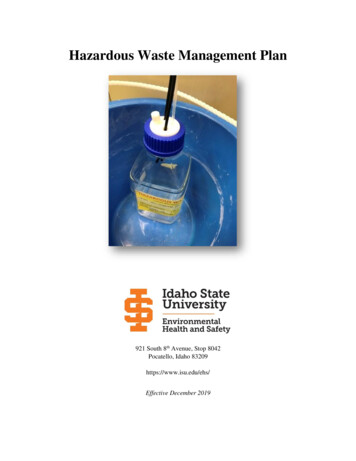
Transcription
Universal Waste GuideEnvironmental Health and Safety
Table of ContentsI.Purpose . 2II.Scope . 2III. Definitions . 2IV. Responsibilities . 3V.Universal Waste Management Program . 4VI. Universal Waste Management Procedures – Batteries . 5VII. Universal Waste Management Procedures – Mercury-Containing Equipment . 5VIII. Universal Waste Management Procedures – Lamps . 5IX. Response to Releases. 6X.Off-Site Shipment Procedures . 6XI. Tracking Universal Waste Shipments. 6XII. Regulatory Authority. 6XIII. Contact . 6Universal Waste GuideEnvironmental Health and Safety July 20171
I.II.III.PurposeThis program establishes the process for Northwestern University to a) comply with all federal,state, and local regulations to minimize and dispose of universal waste; b) ensure the protectionof human health and the environment; c) ensure safe use, minimization, storage, and disposal ofuniversal waste generated on campus.ScopeThis program applies to all employees and contractors who handle universal wastes, such asbatteries, lamps, and mercury at Northwestern University. As a large quantity universal wastegenerator, Northwestern University accumulates at least 11,000 pounds of universal waste atany time.DefinitionsA. “Battery” means a device consisting of one or more cells, in which chemical energy isconverted into electricity and used as a source of power that is designed to receive,store, and deliver electric energy. The term battery also includes an intact, unbrokenbattery from which the electrolyte has been removed.Battery TypeCommon UseHazardous ComponentAlkaline and Carbon zincCameras, handheldNon-toxic, can leak withAAA, AA, C, D, 9 voltelectronicsageLead-acid gelAutomotive, portable tools,Lead, acid electrolyteoutdoor power equipmentLithiumCameras, handheldNon-toxic, can overheatAAA, AA, 9 voltelectronics, tire-pressureor explode if shortsensors, alarms, memorycircuitedbackup, high-temperatureapplications,Li-ionCell phones, laptops, tablets, Non-toxicpower tools, handheldelectronics, digital camerasMercuryCameras, digitalMercuryAA, 9 voltthermometers, calculators,medical devicesNickel-cadmiumCell phones, laptops, tablets, CadmiumAAA, AA, C, Dpower tools, handheldelectronicsNickel metal hydrideCell phones, laptops, powerNon-toxicAAA, AA, C, D, 9 volt, 12tools, cameras, handheldvoltelectronicsSilver oxideHearing aids, camerasNon-toxicUninterruptible powerStationary powerAcid electrolytesupply (UPS)Zinc airHearing aidsNon-toxic9 voltB. “Battery waste” becomes universal waste on the date that it is removed from servicebecause it is no longer operable, or no longer wanted or needed.Universal Waste GuideEnvironmental Health and Safety July 20172
C. “Generator” means any person, or site, whose act or process produces universal waste.D. “Lamp” or “universal waste lamp” is defined as the bulb or tube portion of an electriclighting device. Common examples of universal waste lamps include, but are not limitedto, fluorescent, high intensity discharge, neon, mercury vapor, high pressure sodium,and metal halide lamps. Incandescent lamps (i.e., normal household lamps) are notconsidered to be universal waste and may be disposed of in the regular trash.E. “Lamp waste” or “universal waste lamp waste” becomes universal waste on the datethat it is removed from service because it is no longer operable, or no longer wanted orneeded.F. “Mercury-containing equipment” means a device or part of a device (includingthermostats, thermometers, barometers, manometers, blood pressure cuffs, mercuryswitches, but excluding batteries and lamps) that contain elemental mercury integral toits function.G. “Mercury-containing equipment waste” becomes universal waste on the date that it isremoved from service because it is no longer operable, or no longer wanted or needed.H. “Thermostat” means a temperature control device that contains metallic mercury in anampule attached to a bimetal sensing element and mercury-containing ampules thathave been removed from the temperature control device in compliance with Section733.113(c)(2) or 733.133(c)(2).I. “Thermostat waste” becomes universal waste on the date that it is removed fromservice because it is no longer operable, or no longer wanted or needed.J. “Universal waste” are hazardous wastes that are commonly generated in a widervariety of establishments. Recycling of universal waste is encouraged, unless broken ordamaged. Damaged and broken universal waste materials must be treated as hazardouswaste.K. “Universal waste handler” is: (1) a generator of universal waste, or (2) one who receivesuniversal waste from other universal waste handlers, (3) or who accumulates universalwaste, and sends universal waste to another waste handler.IV.ResponsibilitiesA. Facilities Operationsi.Properly handle all universal waste generated;ii.Ensure that all universal wastes identified or generated through constructionand renovation projects are properly handled and disposed.B. Facilities Project Managers and Contractorsi.Ensure that any demolition/renovation projects that may generate universalwaste are conducted in accordance with this program;ii.Ensure contractors hired to remove, store, and dispose of universal waste arehandled in a manner consistent with this program.C. Departments and Units (i.e., Residential Services, Athletics, and other departments)i.Properly handle all universal waste generated;ii.Ensure handlers are properly trained.D. Research Safety (ORS), Environmental Health and Safety (EHS), and sustainNUi.Periodically inspect accumulation areas to ensure containers are properlylabeled, closed, and not leaking or damaged;ii.Periodically update this program as needed;iii.Facilitate or coordinate universal waste training for handlers of universal waste.Universal Waste GuideEnvironmental Health and Safety July 20173
iv.Maintain records associated with training for staff assigned to manage andhandle universal waste.E. Universal Waste Vendorsi.Maintain all records, including waste manifests and shipment receipts,associated with battery, lamp, and mercury-containing equipment wastes;ii.Periodically inspect battery, lamp, and mercury-containing equipmentaccumulation areas to ensure containers are properly labeled, closed, and notleaking or damaged;iii.Respond to any releases.V.Universal Waste Management ProgramIt is expected that universal waste will be generated while replacement of batteries, lamps, ormercury-containing equipment; and during construction and demolition or renovation projectsin areas where battery, lamp, and mercury-containing equipment wastes exist and requiredisposal.A. Universal Waste Accumulation AreasNorthwestern collects and stores universal wastes at the following locations:i.2020 Ridge Ave (sustainNU), Universal Waste Central Accumulation Area: lampsii.2020 Ridge Ave (Auto Shop), Universal Waste Accumulation Area: vehicle leadacid batteriesiii.2145 Sheridan Rd, Universal Waste Central Accumulation Area: batteriesiv.910 University (Electric Shop), Universal Waste Central Accumulation Area:lamps, batteriesv.Ward Building B-106 (ORS), Universal Waste Central Accumulation Area:batteriesB. Accumulation Time LimitsUniversal waste may accumulate for no longer, than one year from the date theuniversal waste was generated. To demonstrate that universal waste is not onsite forlonger than a year, the date must be logged on the universal waste container once thefirst item (battery, lamp, thermometer, etc.) is placed in a container.C. Storage and Handlingi.Do not place universal waste in the trash.ii.Do not treat any universal waste, except during a response to a release or spill.iii.All universal waste must be handled in a manner that prevents a release of anymaterials or components.iv.All universal waste containers must remain closed at all times except whenadding or removing waste. The containers must be compatible with theuniversal waste contents and free of defects or damage that would causeleakage, spills, or other environmental releases.v.Universal waste stored outside must be covered, to prevent precipitation fromcontacting the waste.D. Trainingi.All employees handling universal waste must be thoroughly familiar with properuniversal waste handling, including personal protective equipment, andemergency procedures.ii.Personnel must successfully complete training prior to beginning work, andattend annual refresher training.Universal Waste GuideEnvironmental Health and Safety July 20174
VI.Universal Waste Management Procedures – BatteriesA. A battery collection box can be picked up or batteries can be dropped off at ORS locatedin Technological Institute NG-71.B. Separate any batteries that show evidence of leakage, spillage or damage that couldcause leakage in another container.C. Boxes include the start date, and will be returned to ORS within 9 months:i.Evanston ORS drop-off: Technological Institute NG-71ii.Chicago ORS drop-off: Ward Building B-106D. Employees handling batteries may conduct the following activities:i.Sorting of batteries;ii.Mixing batteries in one container.VII. Universal Waste Management Procedures – Mercury-ContainingEquipmentA. Ensure containers and lids are closed except when mercury-containing equipment areadded or removed;B. Containers must remain closed, be structurally sound, compatible with the mercury, andlack evidence of leakage, spillage or damage that could cause leakage under reasonableforeseeable conditions;C. Containers for mercury-containing equipment must be labeled or marked clearly asfollows:i.“Universal Waste – Mercury-Containing Equipment” or “Waste – MercuryContaining Equipment”ii.The original product label (if legible); oriii.The chemical identity of the container; andiv.The name of the person disposing the mercury-containing equipment; andv.Contact information of the person disposing the mercury-containing equipment.vi.The date of when the container becomes full.VIII. Universal Waste Management Procedures – LampsA. Ensure containers and lids are closed except when lamps are added or removed;B. Containers must remain closed, be structurally sound, compatible with lamps;C. Containers for lamps must be labeled or marked clearly as “Universal Waste – Lamps” or“Waste – Lamps,” and must include the date of when the container becomes full.D. Broken lamps are to be cleaned per the following:i.Before cleanup:a. Should a bulb break while hot, be sure to let cool and wait 30 minutesbefore handling.b. Have people leave the room, air out the room for 5-10 minutes byopening a window or door.c. Collect materials needed to clean up broken bulb:d. stiff paper or cardboard;e. sticky tape (sticky rollers are available in ORS);f. damp paper towels or disposable wet wipes (for hard surfaces); andg. a glass jar with a metal lid or a sealable plastic bag.Universal Waste GuideEnvironmental Health and Safety July 20175
ii.iii.During cleanup:a. Do not vacuum- vacuuming is not recommended unless broken glassremains after all other cleanup steps have been taken. Vacuuming couldspread mercury-containing powder or mercury vapor.b. Scoop up glass fragments and powder using stiff paper or cardboard. Usesticky tape to pick up any remaining small glass fragments and powder.Place the used tape in the glass jar or plastic bag.After cleanup:a. Promptly place all bulb debris and cleanup materials, including vacuumcleaner bags, in a labelled container that will prevent release of the piecesto the environment and store in designated accumulation area until disposalis scheduled.IX.Response to ReleasesX.Off-Site Shipment ProceduresXI.Tracking Universal Waste ShipmentsXII.Regulatory AuthorityA. Trained and authorized personnel must immediately contain all spill releases ofuniversal waste. Refer to the Purple Guide for more information.B. If there is a release, it must be determined whether any material resulting from arelease is hazardous waste, and if so, must manage the hazardous waste in compliancewith all applicable requirements of 40 CFR parts 260 through 272. The handler isconsidered the generator of the material resulting from the release, and is subject to 40CFR part 262.C. All release response handlers will be HAZWOPER trained; if the generator is notHAZWOPER trained, contact ORS.Only certified Northwestern employees can re-locate universal waste to storage locations.The hazardous waste manager retains records, including waste manifests, waste profiles,transportation vendor, disposal method, and inspection records for at least three years from theshipment date of universal waste.Northwestern and contractors will comply with the Occupational Safety and HealthAdministration’s (OSHA) standards and any other applicable codes and standards, including:Title 35, Illinois Administrative Code, Subtitle G, Part 733 – Standards for Universal WasteManagementTitle 40 CFR 273 – US Environmental Protection Agency Standards for Universal WasteManagementXIII. ContactFor questions, contact Environmental Health and Safety at ehs@northwestern.edu.Universal Waste GuideEnvironmental Health and Safety July 20176
A. Ensure containers and lids are closed except when lamps are added or removed; B. Containers must remain closed, be structurally sound, compatible with lamps; C. Containers for lamps must be labeled or marked clearly as "Universal Waste - Lamps" or "Waste - Lamps," and must include the date of when the container becomes full.











